Monetary analysts produce monetary plans , projections and analytical reviews to be used in funding decisions by corporations, private and non-private organizations, and individuals. The primary regulatory organization for the securities trade is the Financial Trade Regulatory Authority (FINRA). Nearly all of these licenses require sponsorship by an employer, so firms don’t expect individuals to have these licenses before starting a job.
Monetary analysts who work internationally could find the Licensed International Investment Analyst (CIIA) from the Affiliation of Licensed Worldwide Investment Analysts useful in advancing their careers. Monetary analysts generally concentrate on developments affecting a specific trade, geographical area, or sort of product.
Risk analysts evaluate the risk in portfolio decisions, predict potential losses, and advocate funding decisions to limit potential losses. Analysts are likely to read publications similar to The Wall Street Journal, The Monetary Times and The Economist as well as financial websites.
ERP (enterprise resource planning) techniques: Financial analysts have to make use of ERPs for managing and automating finance-related tasks on the back end of a enterprise. In 2012, about 45 {91eeb8b4fd271bd4d1e056c0f6f68647b4f9a693f1217c93a23de392f6e4868f} of monetary analysts worked in finance and insurance coverage industries.

Conversely, promote facet analysts help securities sellers, similar to banks and other firms, sell stocks, bonds, and other investments. Monetary analysts follow monetary modeling, which involves utilizing mathematical equations to predict future performance primarily based on previous efficiency taking variables such as inflation into consideration.


